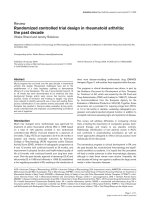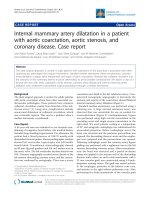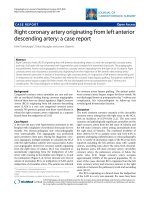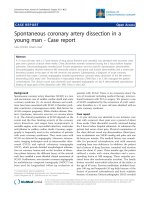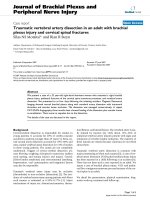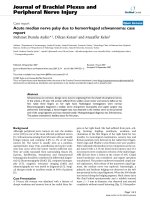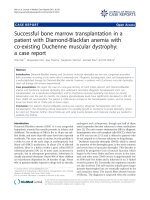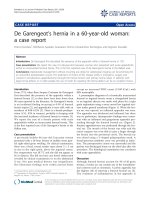Báo cáo y học: "Spontaneous coronary artery dissection in a young man - Case report" docx
Bạn đang xem bản rút gọn của tài liệu. Xem và tải ngay bản đầy đủ của tài liệu tại đây (1.02 MB, 4 trang )
CAS E REP O R T Open Access
Spontaneous coronary artery dissection in a
young man - Case report
Julia Schmid, Johann Auer
*
Abstract
A 31 year old man with a 17-year-history of drug abuse (heroine and cannabis) was admitted with recurrent chest
pain over a period of about three weeks. Chest discomfort severely worsened during the 5 hours before hospital
admission. Electrocardiography revealed poor R-wave progression and non specific repolarization abnormalities.
Echocardiography showed extensive left ventricular anterior and apical wall motion abnormalities and a ventricular
thrombus located at the apex of the left ventricle was present. Subsequently, a diagnosis of acute coronary
syndrome was made. Coronary angiography revealed spontaneous coronary artery dissection of the left anterior
descending (LAD) artery with Thrombolysis In Myocardial Infarction (TIMI) flow 2 to 3. We managed the patient
conservatively. The clinical course was uneventful and repeated angiography on day 4 demonstrated spontaneous
healing of large parts of the dissection with TIMI 3 flow in the LAD.
Background
Spontaneous coronary artery dissection (SCAD) is a rare
and uncommon case of sudden cardiac death and acute
coronary syndrome [1]. As several diseases and condi-
tions have been associated with SCAD it therefore prob-
ably constitutes a heterogeneous entity. Risk factors for
SCAD comprise pregnancy, Ehlers-Danlos disease, Mar-
fan’ s Syndrome, intensive exercise, or cocaine abuse
[1-4]. The clinical presentation of SCAD depends on the
extent and the flow limiting severity of the coronary
artery dissection, and range s from asymptomatic to
unstable angina, acute myocardial infarction, ventricular
arrhythmias to sudden cardiac death. Coronary angio-
graphy is frequently used in the evaluation of patients
with acute coronary syndromes. Thus, most cases with
SCAD are detected by angiography. Moreover, intracor-
onary imaging techniques such as intravascular ultra-
sound (IVUS) and optical coherence tomography
(OCT), which provide detailed morphological informa-
tion on coronary lesions and on the location of dissec-
tion planes between the different layers of the arterial
wall, have enabled a more detailed clinical assessment of
SCAD. Furthermore, non-invasive coronary angiograp hy
by multidetector computed tomography ( MDCT) has
been used for longitudinal follow-up evaluation of
patients with SCAD. There is no consensus about the
way of treatment including medical therapy, interven-
tional treatment with PCI or surgery. We present a case
of SCAD co mplicated by the occurrence of a left ventri-
cular thrombus in a 31 years old man admitted w ith an
acute coronary syndrome.
Case report
A 31-year old man was admitted to our intensive care
unit with recurrent chest pa in over a period of about
three weeks. Chest discomfort severely worsened during
the 5 hours before hospital admission. At admiss ion the
patient had severe chest pain. Physical examination of
the chest did not reveal any abnormalities. Blood pres-
sure at admission was 150/85 mmHg and pulse rate was
86 beats per minute. The medical history was remark-
able for p aranoid schizophrenia and mild anaemia
resulting from iron deficiency. In addition, the patient
had a history of drug (heroine, cannabis) and nicotine
abuse for about 17 years. Three months ago, the patient
suffered a stroke with vision disorders and a corre-
sponding lesion at MR imaging. There sequelae per-
sisted from this cerebrovascular accident. The family
history revealed myocardial infarction of the father at
the age of 65 years. Previous medication included cloza-
pine 100 mg and benper idol 10 mg daily because of the
history of paranoid schizophrenia and ferric sulphate
because of anaemia. Electrocardiography (ECG) revealed
* Correspondence:
Department of Cardiology and Intensive Care, General Hospital Braunau,
Austria, Ringstrasse 60, A - 5280 Braunau am Inn, Austria
Schmid and Auer Journal of Cardiothoracic Surgery 2011, 6:22
/>© 2011 Schmid and Au er; licensee BioMed Ce ntral Ltd. Thi s is an Op en Access article distributed under the terms of the Creative
Commons Attribu tion License (http ://creat ivecommons.org/licenses/by/2.0), which permits unrestricted use, distribution, and
reproduction in any medium, provided the original work is properly cited.
sinus rhythm and poor R-wave progression and non
specific repolarization abnormalities (Figure 1). Echocar-
diography showed extensive left ventricular anterior and
apical wall motion abnormalities and a ventricular
thrombus located at the apex of t he left ventricle
(Figure 2). Cardiac troponine I was 0,681 ng/ml (Abbott
Laboratories, Illinois, U.S.A.; normal value < 0,032 ng/
ml). The patient was treated with morphine hydrochlor-
ide, aspirin, clopidogrel, nitrates, bisoprolol, and unfrac-
tionated heparin for acute coronary syndrome. Based on
the symptoms, ECG and echocardiographic findings and
a positive cardiac biomarker, early coronary angiography
was performed. The left anterior descending (LAD)
artery showed extensive dissection with visible tear from
the proximal part of the vessel to the apical LAD seg-
ment. The TIMI (thrombolysis in myocardia l infarction)
flow grade was 2+ (Figure 3, 4, 5). The right coronary
artery (RCA) and the circumflex artery were normal. At
thetimeofcoronaryangiography,chestpainhad
resolved completely. Based on the morphology of the
vessel with an extensive dissection and TIMI II+ flow,
we decided to manage this patient conservatively with
close follow up. We continued unfractionated heparin to
establish an activated partial thromboplastin time
between 60 and 80 seconds (normal range 25 to 40 sec-
onds), nitrates, dual antiplatelet therapy bisoprolol, and
ramipril. On day 3 repeated coronary angiography
showedaTIMIflowgrade3intheLAD.Theintimal
tear was again visible with limited extent compared to
the initial study. On day 5 we found no angiographically
visible intimal tear any more. A diameter reduction of
theproximalpartoftheLADofabout40to50%per-
sisted (Figure 6). The clinical course during hospital stay
was uneventful. The patient could be discharged for car-
diac rehabilitation 9 days after admission. Post-discharge
treatment included dual antiplatelet therapy (aspirin 100
mg daily temporally unlimited, clopidogrel 75 mg daily
for 12 months) in combination with phenprocoumone
(international normalized ratio 2 to 3) for 3 months due
to the left ventricular thrombus.
Discussion
Spontaneous coronary artery dissection (SCAD) is a rare
cause of acute coronary syndrome first described in
1931 [5]. The ratio female to men is 2:1 and the dissec-
tion is more frequently diagnosed in the left coronary
artery [6]. Coronary artery dissection is characterized by
a separation of the layers of the artery wall. This results
in a false lumen or an intramural haematoma in the
area of the media [2]. Coronary angiography is the pri-
mary tool for diagnosis of SCAD. Intracoronary imaging
techni ques such as intravascu lar ultrasound (IVUS) and
optical coherence tomography (OCT), which provide
detailed morphological information on coronary lesions
Figure 1 Electrocardiogram at admission with poor R-wave
progression and non specific repolarization abnormalities.
Figure 2 Transthoracic echocardiography; 4 chamber view
reveals left ventricular thrombus.
Figure 3 Coronary angiography in RAO view with dissection of
the left anterior descending artery.
Schmid and Auer Journal of Cardiothoracic Surgery 2011, 6:22
/>Page 2 of 4
and on the location of dissection planes between the dif-
ferent layers of the arterial wall, have enabled a more
detailed clinical assessment of SCAD [2]. Furthermore,
non-invasive coronary angiographybymultidetector
computed tomography (MDCT) has been used for long-
itudinal follow-up evaluation of patients with SCAD.
We did no t utilize IVUS in the patient present ed in this
report because angiographic assessment revealed high
diagnostic accuracy. We did not expect further informa-
tion from additional imaging that might have changed
clinical decision making. SCAD occurs during pregnancy
in 26,1% of the cases. In this patient population, SCAD
was diagnosed most frequently during the postpartum
period [7,8]. SCAD may be associated with Marfan’ s
Syndrome, Ehlers-Danlos Disease, intensive exercise and
cocaine abuse, female hormonal treatment s as oral con-
traceptives, although in some cases no predictor could
be identified [1-4]. A hereditary factor has been dis-
cussed previously [9]. There are no randomized trials on
treatment of coronary artery dissection. The literature
consists of case reports and case series. Different strate-
gies of treatment have been discussed in the last years.
Conservative management of patients with SCAD is a
possible treatment strategy in stabile patients [10]. Anti-
platelet therapy can be used because of the flow limita-
tions caused by platelet thrombi [1]. GP IIb/IIIa
inhibitors have been successfully used in patients with
SCAD [2,11]. We did not use a GP IIb/IIIa inhibitor in
the present patient because of clinical success with dual
antiplatelet therapy and heparin and risk-benefit
calculation with respect to the recent stoke. However,
utilization of a GP I Ib/IIIa inhibitor would have been
our bail-out-strategy. Koller et al. reported a sponta-
neous healing of the lesion of a postpartum SCAD with
the treatment including prednisone and cyclophospha-
mide combined with the conventional therapy [12].
Stent implantation can be performed in limited disease
after identification of the true and false lume n [13].
Figure 5 Coronary angiography in LAO view with dissection of
the left anterior descending artery.
Figure 6 Coronary angiography in RAO view 5 days after
admission with dissection of the LAD.
Figure 4 Coronary angiography in posterior-anterior view with
caudal angulation with dissection of the LAD.
Schmid and Auer Journal of Cardiothoracic Surgery 2011, 6:22
/>Page 3 of 4
Fibrinolysis is not recommended due to the increase of
the bleeding risk [1]. In the case of multivessel dissec-
tion, coronary artery bypass graft (CABG) may be a rea-
sonable choice [14]. In conclusion spontaneous coronary
arterydissectionisanuncommondisease,morefre-
quently seen in women without cardiac risk factors [1].
The postpartum period, cocaine, intensive exercise and
diseases like Ehlers-Danlos are risk factors for SCAD
[1-4]. The management strategy has to be based on clin-
ical presentation, additional findings and morp hological
details during invasive assessment in a case by case
fashion.
Consent
Written informed consent was obtained from the patient
for publication of this case report and accompanying
images. A copy of the written consent is available for
review by the Editor-in-Chief of this journal.
Authors’ contributions
JS was the main author and wrote the article. JA was the cardiology
consultant and gave final approval of the manuscript. All authors have read
and approved the final manuscript.
Competing interests
The authors declare that they have no competing interests.
Received: 10 January 2011 Accepted: 3 March 2011
Published: 3 March 2011
References
1. Butler R, Webster MWI, Davies G, Kerr A, Bass N, Armstrong G, Steward JT,
Ruygrok P, Ormiston J: Spontaneous dissection of native coronary
arteries. Heart 2005, 91:223-224.
2. Auer J, Punzengruber C, Berent R, Weber T, Lamm G, Hartl P, Eber B:
Spontaneous coronary artery dissection involving the left main stem:
assessment by intravascular ultrasound. Heart 2004, 90:e39.
3. Hering D, Piper C, Hohmann C, Schultheiss HP, Horstkotte D: Prospective
study of the incidence, pathogenesis and therapy of spontaneous, by
coronary angiography diagnosed coronary artery dissection. Z Kardiol
1998, 87:961-70.
4. Jorgensen MB, Aharonian V, Mansukhani P, Mahrer PR: Spontaneous
coronary dissection: a cluster of cases with this rare finding. Am Heart J
1994, 127:1382-7.
5. Pretty HC: Dissecting aneurysm of coronary artery in a woman aged 42.
BMJ 1931, i:667.
6. Verma PK, Sandhu MS, Mittal BR, Aggarwal N, Kumar A, Mayank M,
Bhattacharya A, Anand RK, Grover A: Large spontaneous coronary artery
dissections: a study of three cases, literature review, and possible
therapeutic strategies. Angiology 2004, 55:309-318.
7. Shamloo BK, Chintala RS, Nasur A, Ghazvini M, Shariat P, Diggs JA,
Singh SN: Spontaneous coronary artery dissection: aggressive vs.
conservative therapy. J Invasive Cardiology 2010, 22:222-8.
8. Kilic ID, Tanriverdi H, Evrengul H, Gur S: A Spontaneous Coronary Artery
Dissection Case Noticed during a Primary PCI. Cardiol Res Pract 2010,
794026.
9. Wisecarver J, Jones J, Goaley T: Spontaneous coronary artery dissection.
The challenge of detection, the enigma of the cause. Am J Frensic Med
Pathol 1989, 10:60-2.
10. Missouris CG, Ring A, Ward D: A young woman with chest pain. Heart
2000, 84:e12.
11. Cheung S, Mithani V, Watson RM: Healing of spontaneous coronary
dissection in the context of glycoprotein IIb/IIIa inhibitor therapy: a case
report. Catheterization and Cardiovascular Interventions 2000, 51:95-100.
12. Koller PT, Cliffe CM, Ridley DJ: Immunosuppressive therapy for
peripartumtype spontaneous coronary artery dissection: case report and
review. Clinical Cardiology 1998, 21:40-46.
13. Roig S, Gomez JA, Fiol M, Guindo J, Perez J, Carrillo A, Esplugas E, Bayés de
Luna A: Spontaneous coronary artery dissection causing acute coronary
syndrome: an early diagnosis implies a good prognosis. Am J Emerg Med
2003, 21:549-51.
14. Ooi A, Lavrsen M, Monro J, Langley SM: Successful emergency surgery on
triple-vessel spontaneous coronary artery dissection. European Journal of
Cardio-Thoracic Surgery 2004, 26
:447-449.
doi:10.1186/1749-8090-6-22
Cite this article as: Schmid and Auer: Spontaneous coronary artery
dissection in a youn g man - Case report. Journal of Cardiothoracic Surgery
2011 6:22.
Submit your next manuscript to BioMed Central
and take full advantage of:
• Convenient online submission
• Thorough peer review
• No space constraints or color figure charges
• Immediate publication on acceptance
• Inclusion in PubMed, CAS, Scopus and Google Scholar
• Research which is freely available for redistribution
Submit your manuscript at
www.biomedcentral.com/submit
Schmid and Auer Journal of Cardiothoracic Surgery 2011, 6:22
/>Page 4 of 4
